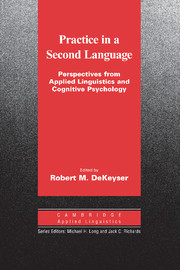Conclusion: The future of practice
Published online by Cambridge University Press: 27 January 2010
Summary
Agreed-on goals in language teaching
The goals of language learning and teaching in general and of practice in particular are manifold. In fact, they are characterized by such a complex array of partially overlapping distinctions that few people ever reflect on this whole array, focusing instead on the distinctions that are most relevant to their own interests or experiences. If practice is to be a set of means to reach a set of goals, however, it is important that we stop and reflect on those goals before continuing.
Even the layperson who has barely set foot in a second language classroom will recognize the distinctions between oral and written language and between the ability to produce and to comprehend. Combining these two distinctions, we get the traditional division among the four skills: listening, speaking, reading, and writing. It is clear for all to see that even in one's native language, and a fortiori in a second language, different people have different levels of need for and proficiency in these four skills. Many people do not aspire to be good writers, even in their L1, and some, even in these days of instant global communication, care more about their ability to understand written text in a second language than about their ability to speak that language because their careers as students or professionals require massive L2 reading but hardly any spoken interaction.
Applied linguists typically make at least three more important distinctions.
- Type
- Chapter
- Information
- Practice in a Second LanguagePerspectives from Applied Linguistics and Cognitive Psychology, pp. 287 - 304Publisher: Cambridge University PressPrint publication year: 2007
References
- 26
- Cited by



